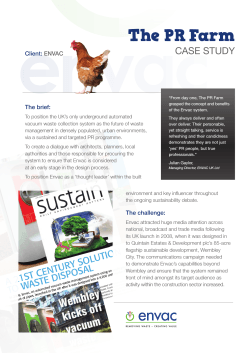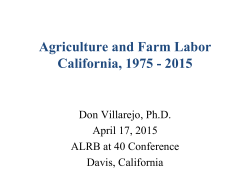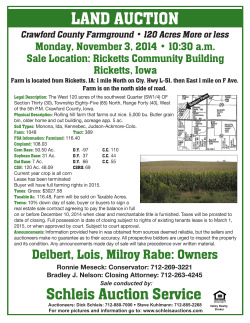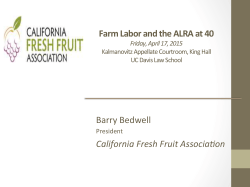
CAIRNGORMS NATIONAL PARK AUTHORITY
CAIRNGORMS NATIONAL PARK AUTHORITY Planning Committee Agenda Item 9 17/04/2015 CAIRNGORMS NATIONAL PARK AUTHORITY Title: CONSULTATION FROM ANGUS COUNCIL Prepared by: KATHERINE DONNACHIE PLANNING OFFICER (DEVELOPMENT MANAGEMENT) DEVELOPMENT PROPOSED: Erection of a Wind Farm comprising 14 Wind Turbines with blade tips up to 115M, foundations, crane hardstandings, around 14km of access track, two borrow pits, a permanent anemometry mast and ancillary works on land at Black Hill/Saddlehill, Glen Isla, Angus REFERENCES: Council Reference -14/00947/EIAM CNPA Reference - 2015/0015/PAC APPLICANT: WIND PROSPECTS DEVELOPMENTS 2 LTD RECOMMENDATION: NO OBJECTION 1 CAIRNGORMS NATIONAL PARK AUTHORITY Planning Committee Agenda Item 9 17/04/2015 2 CAIRNGORMS NATIONAL PARK AUTHORITY Planning Committee Agenda Item 9 17/04/2015 PURPOSE OF REPORT 1. The purpose of this report is to provide a consultation response to Angus Council (the determining Authority for this application) on this proposed wind farm which lies to the south of the Cairngorms National Park. The application is accompanied by an Environmental Impact Assessment (EIA). 2. The planning issues being considered in relation to this consultation are whether there are any impacts upon the qualities of the National Park. SITE DESCRIPTION AND PROPOSED DEVELOPMENT Site Description 3. The application site is located partly within the boundaries of Angus Council (eight turbines) and partly within the boundaries of Perth and Kinross Council (six turbines) at Saddlehill which is located some 7.5 km south of the Cairngorms National Park boundary as shown in Figure 1. The site is located around 7 km to the north of Alyth and around 10 km to the north east of Blairgowrie. 4. The site comprises moorland and forestry plantation, bounded by forestry plantation to the north and west and by moorland and pasture land to the south. Commercial forest will be felled to accommodate the development. 5. It lies to the east of the existing Drumderg wind farm and north of the consented Tullymurdoch wind farm. Proposed Development 6. The scheme proposes the erection of 14 wind turbines of hub height 70 metres and height to tip of 115 metres. The rotor blade length is 45 metres. Each turbine has a maximum generating capacity of 2.5 MW giving a total combined generating capacity of 35 MW. Other components of the development are as follows: a) b) c) d) e) Crane hardstanding and temporary construction compound Access roads Culverted watercourse crossings Wind monitoring mast (anemometer) Electrical connection including switchgear building. The grid connection point is expected to be at Cupar Angus substation, although this cannot be confirmed at present. All electrical cables within the wind farm will be underground. f) Two on-site borrow pits Figure 2 shows the site layout 3 CAIRNGORMS NATIONAL PARK AUTHORITY Planning Committee Agenda Item 9 17/04/2015 Figure 2 Site Layout 7. The application was accompanied by an Environmental Statement (ES) which covered the following key areas: a) Landscape and Visual Impact Assessment (LVIA) which sets out the landscape design objectives which included the need to ensure design compatibility with the Drumderg and Tullymurdoch wind farms in the area, and to limit the potential cumulative impacts upon the Cairngorms National Park. The study area was based upon a 35 km distance from each turbine location and 27 viewpoints were considered. These included: 1) Five in the National Park at Dreish (VP17 at 17.7 km from the wind farm) 2) Meall Odhar (VP14 at 12 km away from wind farm) 3) Glas Maol (VP22 at 19 km from the wind farm ) 4) Loch Brandy (VP23 at 23.3 km from wind farm) 5) Beinn a Ghlo (VP26 at 28.3 km from wind farm) Viewpoints at Glen Isla (Forter VP10) also provided indication of impacts in Glen Isla. Zone of Theoretical Visibility information (ZTV) was provided along with viewpoint analysis, photomontages and wire frame visualisations. A cumulative landscape and visual impact assessment was also undertaken b) Wild land assessment which considered impacts upon the Cairngorms Wild Land Area (as identified by Scottish Natural Heritage) which lies to the north west, and the Lochnager-Mount Keen wild land area (WLA) 4 CAIRNGORMS NATIONAL PARK AUTHORITY Planning Committee Agenda Item 9 17/04/2015 c) d) e) f) g) h) i) j) k) to the north and north west. Viewpoint 26 Beinn a Ghlo lies within the Cairngorms WLA and Viewpoints 17 (Dreish), 22 (Glas Maol), and 23 (Loch Brandy) are all located within the Lochnager and Mount Keen WLA. The assessment concluded that there would not be a significant effect on the wild land areas due mainly to the large intervening distances and visual compatibility of the proposed wind farm with the existing Drumderg wind farm Land use, recreation and access Ecology and Ornithology Hydrology Cultural heritage Telecommunications and aviation Noise Traffic Socio Economic Impacts which highlighted the importance of tourism to the area. This concluded that the development would have no significant visual effects on recreational and tourist destinations within 10 km, nor upon national tourist routes, with some benefits for visitors as a result of the access to site tracks. The overall impact upon tourism is assessed as minor A planning statement was also included to outline the planning policy background etc. This does not specifically reference the National Park Partnership Plan or aspects of Scottish Planning policy relating to the setting of the National Park 8. The ES concluded in respect of the cumulative impact upon the National Park that the proposed wind farm would tend to form a cluster or group of development closely associated with the Drumderg and Tullymurdoch wind farms which all lie to the south of the National Park. It was considered that the intervening distance, landform screening, and limited visibility would limit the potential landscape and visual effects for the National Park. 9. Overall the ES concluded that the proposed Saddlehill wind farm would not greatly alter the overall landscape character and visual amenity. RELEVANT PLANNING HISTORY 10. As members are aware there has been some pressure for new wind farms to the south of the National Park and there are a number of existing and approved wind farms in the vicinity of the application site. Key sites are as follows: (a) Drumderg – an existing wind farm of 16 turbines of height 107 metres to tip (b) Tullymurdoch - The CNPA was consulted by Perth and Kinross Council on an application for 7 wind turbines of height to tip 120 metres. This was considered at the October 2012 Planning Committee meeting and no objections were raised. Consent has been granted for this development following a successful appeal to the Directorate of Planning and Environmental Appeals (DPEA) against non determination 5 CAIRNGORMS NATIONAL PARK AUTHORITY Planning Committee Agenda Item 9 17/04/2015 11. A consultation from the Scottish Government Energy Consents Unit is also currently pending for a proposed wind farm development at Macritch to the north east of the current application site which will come before Committee in due course. 12. These sites are shown in Appendix 1 – Wind Farm Map which shows key sites at planning and pre-planning stage around the National Park. DEVELOPMENT PLAN CONTEXT National Policy and Guidance 13. Scottish Planning Policy (SPP, revised 2014) sets out national planning policies that reflect Scottish Ministers priorities for the operation of the planning system and for the development and use of land. Under planning law, planning applications must be determined according to the development plan unless material considerations indicate otherwise. The content of SPP is a material consideration in planning decisions that carries significant weight. The SPP promotes consistency in the application of policy across Scotland while allowing sufficient flexibility to reflect local circumstances. 14. SPP specifically sets out that the planning system should support the transformational change to a low carbon economy, support the development of a diverse range of electricity generation from renewable energy technologies, and guide development to appropriate locations. In paragraph 154, it sets out the Scottish Government’s commitment to increasing the overall amount of energy generated from renewable sources to 30% by 2020, with the equivalent of 100% of electricity demand being met by renewable sources by this date. In terms of policy principles, paragraph 154 requires the planning system to guide renewable energy development to appropriate locations and to advise on the issues that would need to be taken into account when specific proposals are being assessed. 15. Paragraph 169 sets out the issues to be considered when considering energy infrastructure development proposals including the need to consider likely cumulative impacts and landscape and visual impacts, including effects on wild land. Further advice on wind energy is contained in the Scottish Government online information note on “onshore wind turbines” which set out issues to be considered and references the range of SNH publications and guidance on wind energy and planning. 16. National Parks are highlighted in paragraphs 84 – 86 of the SPP under the “promoting rural development” section. These paragraphs re-state the aims of the National Parks and the need to pursue these collectively. SPP highlights that if there is a conflict between the first aim (conserving and enhancing the natural and cultural heritage of the area) and any of the others then greater weight must be given to the first aim. Planning decisions are expected to reflect this weighting and be consistent with these aims. 6 CAIRNGORMS NATIONAL PARK AUTHORITY Planning Committee Agenda Item 9 17/04/2015 17. Paragraph 212 of the SPP highlights that where development affects a National Park it should only be permitted where the objectives of the designation and the overall integrity of the area will not be compromised, or any significant adverse impacts on the qualities for which the area has been designated are clearly outweighed by social, environmental or economic benefits of national importance. 18. SPP also highlights in paragraph 85 that these aims and requirements apply to development outwith a National Park that affects the Park. 19. Wild Land Areas are addressed in paragraph 200 of the SPP (2014) which are identified as being very sensitive to any form of intrusive human activity and have little or no capacity to accept development with the requirement set out for Plans to identify and safeguard the character of areas of wild land as identified in the Scottish Natural Heritage 2014 map of wild land areas. In relation to development management it is highlighted in paragraph 215 that development may be appropriate in some circumstance, and that further consideration is required to demonstrate that any significant effects on the qualities of these areas can be substantially overcome by siting, design or other mitigation. Strategic Policy Cairngorms National Park Partnership Plan 2012-2017 20. The Cairngorms National Park Partnership Plan sets out the vision and overarching strategy for managing the Park and provides focus and priorities at a time of limited financial resources. The Plan also provides a strategic context for the Local Development Plan and shows how the four aims of the National Park can be achieved together. It sets out the strategic direction and priorities for the Park. 21. Three long term outcomes for the Park are set out as follows: 1) A sustainable economy supporting thriving businesses and communities 2) A special place for people and nature with natural and cultural heritage enhanced and 3) People enjoying the park through outstanding visitor and learning experiences These outcomes address the interaction of the three main characteristics of the National Park: these being that the Park is an internationally important area for nature conservation; a fragile rural economy; and an internationally known tourism destination. Recognising the relationship of these outcomes is at the heart of the National Park. A series of work programmes to help deliver the outcomes is set out in the Plan. 7 CAIRNGORMS NATIONAL PARK AUTHORITY Planning Committee Agenda Item 9 17/04/2015 22. Specific policies of the Plan seek to promote and enhance the special qualities of the Park. In particular Policy 1.3 sets out that large scale commercial wind turbines (defined as more than one turbine and more than 30 metres in height) are not compatible with the special qualities of the National Park and are not considered to be appropriate within the National Park, or where outside the Park they affect its landscape setting. 23. Also relevant is Policy 2.3 which seeks to conserve and enhance the special landscape qualities of the National Park, with a particular focus on conserving and enhancing wildness qualities and enhancing opportunities to enjoy and experience the landscapes of the Park. CONSULTATIONS 24. The Scottish National Park Authorities have agreed an arrangement with Scottish Natural Heritage (SNH) on respective roles in advisory casework. This sets out that SNH will take the lead role in considering the impacts on the National Park designation of proposals outside the Park, with the National Park Authority supporting. Accordingly the views of both SNH and the CNPA Landscape Advisor have been included in this report. 25. Scottish Natural Heritage has commented on this case to Angus Council raising concerns regarding the design of the scheme relative to how it is viewed in conjunction with existing and proposed wind farms at Drumderg and Tullymurdoch, considering that it would create a confusing pattern of wind farm development on the Highland boundary fault resulting in significant adverse cumulative landscape and visual impacts. In relation to impacts upon the National Park, they have noted that this confusing pattern would impact upon walkers on high summits of the mountains to the north, including the Cairngorms National Park. 26. The CNPA Landscape Advisor has assessed this application and a copy of the full response is attached as Appendix 2. The officer highlights that visibility from within the National Park will extend to the slopes of Caenlochan Forest including Glas Maol at approximately 22 km; munro summits at Beinn a Ghlo at approximately 26 km; tops and higher south west facing slopes between Glen Prosen and Glen Clova; some hills around Loch Brandy and hillsides on west of Glen Isla. The site is located on an upland area in the vicinity of the Highland fault line and in views from the National Park appears very much at the edge of the uplands that extend out from the National Park. The Landscape Advisor agrees with the conclusion of the Environmental Statement (ES) that the broader character area of the Highland summits and plateaux will not be significantly affected. 27. Viewpoint assessments in the National Park are from elevated viewpoints, representative of the views likely to be gained by walkers, and key viewpoints are referred to earlier in this report. These demonstrate that there will be low to moderate impacts with the proposed wind farm reading visually with 8 CAIRNGORMS NATIONAL PARK AUTHORITY Planning Committee Agenda Item 9 17/04/2015 other wind farms. The effects of the proposed Saddlehill wind farm on its own are not considered to be significant from all of the viewpoints in the National Park. Accordingly it is the cumulative impact that requires to be considered, in particular combined effects with Drumderg and Tullymurdoch. Visual complexity will be created as a result of the three wind farms as they will be seen at various points as strung out as a single wind farm or as overlapping or closely associated groups of turbines. It is considered that this will have a moderate effect on the visual amenity of walkers rather than the negligible effect concluded in the ES. 28. In terms of impacts upon the setting of the National Park, the wind farm will appear at the very edge of the uplands extending out from the Park as noted earlier. It is concluded that in view of the juxtaposition of potential viewer locations, wind farm location, landscape character and distance, the proposed wind farm will not have a significant adverse effect upon the setting of the National Park. 29. Although the wind farm will be experienced from a number of locations in the National Park, it is not considered to significantly affect the integrity of the Park. Whilst there will be locations in the southern part of the National Park where viewers would experience a cumulative effect with other wind farms this is not considered to have a significant adverse effect upon the special landscape qualities of the Park. 30. Finally in terms of wild land, the Landscape Advisor concurs with the ES assessment conclusions that there will be no significant effect on wild land areas although there is a risk that the cumulative effects on visual amenity could affect the arresting and inspiring qualities that walkers experience. 31. The Landscape Advisor has concluded that the cumulative visual effect of Saddlehill in addition to existing and consented wind farms will be noticeable, or even marked, to some people. As such this will affect the experience and appreciation of the National Park’s landscape and perhaps for some people the sense of wildness. However, the level of effect is such that the proposal is considered to meet the policy tests in respect of the National Park as noted within the officer response. APPRAISAL 32. As noted earlier the proposed wind farm is located on a site which lies around 7.5 km (at its closest point) away from the southern boundary of the National Park, at the very edge of the uplands which extend out of the National Park. The key planning issue for consideration is that of the visual and landscape impact upon the setting of the National Park with both national planning policy and the National Park Partnership Plan setting out the need to consider the impacts of such development upon the setting of the National Park. 9 CAIRNGORMS NATIONAL PARK AUTHORITY Planning Committee Agenda Item 9 17/04/2015 33. The applicant’s Environmental Statement suggests that the proposed development would not significantly affect the special qualities of the National Park, with viewpoints from a number of points in and around the Park provided which seek to substantiate this view. As noted earlier the CNPA Landscape Advisor concurs with this view. 34. Whilst there is always some concern about the incremental changes to the landscape as a result of new wind turbine development, it is necessary to consider whether or not the proposal will affect the landscape setting of the National Park and its special qualities. In this regard it is considered that due to the distance from the National Park and importantly the location of the site at the very edge of the upland areas leading out from the National Park there is not a significant impact upon the setting or special qualities in this instance, or indeed upon wildness. 35. The site is located in an area where there is already wind farm development with which it will read visually. Whilst there may also be some concern regarding how the development sits with these existing and consented wind farms, as expressed by Scottish Natural Heritage, this is an issue for the more localised landscape as it is not considered to have a significant adverse impact upon the qualities of the National Park. CONCLUSION 36. In these overall circumstances it is considered that the proposed development could proceed without detriment to the landscape character, setting and special qualities of the National Park. It is therefore recommended that the CNPA raise no objection to the proposed development. RECOMMENDATION That Members of the Committee support a recommendation of NO OBJECTION to the Erection of a Wind Farm comprising 14 Wind Turbines with blade tips up to 115M, foundations, crane hardstandings, around 14km of access track, two borrow pits, a permanent anemometry mast and ancillary works on land at Black Hill/Saddlehill, Glen Isla, Angus Katherine Donnachie planning@cairngorms.co.uk 24 March 2015 The map on the first page of this report has been produced to aid in the statutory process of dealing with planning applications. The map is to help identify the site and its surroundings and to aid Planning Officers, Committee Members and the Public in the determination of the proposal. Maps shown in the Planning Committee Report can only be used for the purposes of the Planning Committee. Any other use risks infringing Crown Copyright and may lead to prosecution or civil proceedings. Maps produced within this Planning Committee Report can only be reproduced with the express permission of the Cairngorms National Park Authority and other Copyright holders. This permission must be granted intu advance. 10
© Copyright 2025








